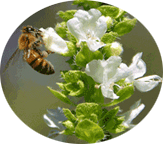Buckwheat, Soaking Grain or Flour
What is Buckwheat?
Buckwheat is not a true grain, but rather the seeds of a plant related to rhubarb. It contains B vitamins (mainly B6 and folic acid), vitamin E, iron and calcium. It also contributes bioflavanoid rutin (see more information below). It contains fewer calories than wheat, corn, or rice. Groats are hulled, crushed buckwheat kernels. Kasha is hulled, toasted buckwheat groats and is available whole and cracked. It is reddish-brown, with a robust earthy flavor and it is gluten-free! However, be cautious about buying "roasted" kasha because it will contain "bad" oils that are damaging to health. Wholegrain buckwheat may be used as a main dish, side dish, added to casseroles or soups, or ground into flour for pancakes, waffles, muffins, and breads. The flour is dark, robust, and slightly sweet.
How to Soak Buckwheat
Soak hard grains overnight in enough water to cover them, plus 1 tablespoon of freshly squeezed lemon juice for each cup. They are cooked in their soaking water.
Buckwheat flour is soaked for 7 hours. When soaking flour for a recipe, use only the amount of liquid and flour in the recipe, and no other ingredients, and also adjust the amount of lemon juice accordingly: 1/2 cup of flour would only required 1/2 tablespoon of lemon juice, whereas 2 cups of flour needs 2 tablespoons of lemon juice.
How to Cook Buckwheat
Use about 2 cups of water per 1 cup of "grains." Bring to boil, reduce heat, and simmer 20 to 30 minutes, or until tender and no longer crunchy (adding extra water, if needed).
For a main dish or side dish, try cooking onions with the buckwheat, and add herbs and ocean sea salt during the last 10 minutes of cooking time.
Kasha (toasted buckwheat): Use slightly less water and reduce cooking time to 15 to 20 minutes.
Groats: Place 1 cup of groats in a frying pan over medium-high heat and stir in one beaten egg; stir constantly until each grain is separate and dry. Add 2 cups of boiling water, reduce heat, cover tightly, and cook 30 minutes. Serve with butter, if desired.
Definitions:
bioflavonoid – any of a group of water-soluble yellow compounds, present in citrus fruits, rose hips, and other plants, that in mammals maintain the resistance of capillary walls to permeation and change of pressure. Also called citrin, vitamin P.
Bioflavonoids, such as Quercetin, Rutin, and Hesperidin, are vital in their ability to increase the strength of the capillaries (blood vessels) and to regulate their permeability. They assist Vitamin C in keeping collagen, the intercellular "cement" in healthy condition; are essential for the proper absorption and use of vitamin C; prevents Vitamin C from being destroyed in the body by oxidation; beneficial in hypertension; helps hemorrhages and ruptures in the capillaries and connective tissues and builds a protective barrier against infections.
Quercetin is a very highly concentrated form of Bioflavonoids derived from citrus fruit. A deficiency in these nutrients may result in varicose veins, a tendency to bruise and bleed easily, and/or the appearance of purplish spots on the skin.
